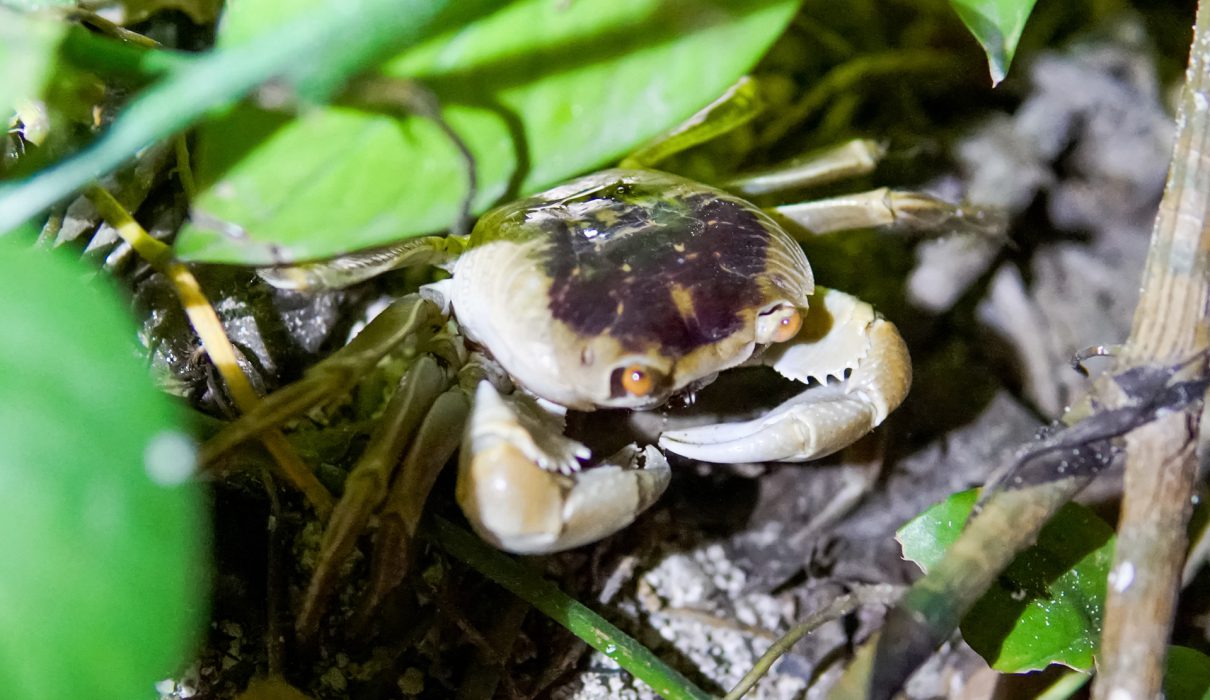Geograpsus grayi, commonly known as the “Little Nipper,” is a species of land crab belonging to the family Grapsidae. This species is native to the coastal and island environments of the Indo-Pacific, including the Maldives. On the island of Noonu Lhohi, as well as other islands across the Maldives, this crab is often observed at night and during rainy days, displaying unique behavioral adaptations. Geograpsus grayi is a nocturnal species, known for its agility and its ability to thrive in the intertidal zones of tropical islands.
Taxonomy
- Kingdom: Animalia
- Phylum: Arthropoda
- Class: Malacostraca
- Order: Decapoda
- Family: Grapsidae
- Genus: Geograpsus
- Species: Geograpsus grayi
- Authority: H. Milne-Edwards, 1853
Description
Geograpsus grayi is a medium-sized land crab with a robust, square-shaped carapace that can range in color from dark brown to light gray, providing excellent camouflage against rocky coastal habitats. The carapace width typically measures between 5 to 8 cm, although larger specimens have been observed. The crab’s chelae (claws) are asymmetrical, with one claw often being larger than the other, a trait that is typical of many crab species.
The legs of G. grayi are adapted for both terrestrial and aquatic environments, with sharp tips and spiny protrusions that allow the crab to grip onto rocks and other surfaces. Its eyes are highly mobile, located on stalks that provide a wide field of vision, making the crab particularly alert to movement.
Behavior
In Noonu Lhohi and other islands of the Maldives, Geograpsus grayi is most active at night and during rainy conditions, displaying its nocturnal and moisture-dependent nature. This crab tends to hide in crevices, burrows, and under rocks during the day, emerging after dark to forage. Rainy weather increases their activity as the wet environment helps prevent dehydration, which is a significant risk for land crabs living outside of water.
Geograpsus grayi is an omnivore, feeding on a variety of food sources including plant matter, small invertebrates, and detritus. It plays an important role in the ecosystem by helping to recycle nutrients and keeping the shoreline clean of organic waste.
Habitat and Distribution
Geograpsus grayi is found throughout the Indo-Pacific region, from the coasts of East Africa to the islands of the Pacific. It inhabits rocky shores, intertidal zones, and sometimes mangroves, where it can seek refuge in crevices or burrows. The species is particularly well-suited to life on small, tropical islands like those in the Maldives, where its behavior is shaped by the cyclical rise and fall of tides.
In the Maldives, Geograpsus grayi is fairly common in coastal areas of various islands, including Noonu Lhohi, where locals often encounter this crab during the night or rainy periods. The species is adapted to the fluctuating conditions of the intertidal zone, capable of moving efficiently between land and water, and utilizing its claws to defend itself and forage for food.
Ecological Importance
As a scavenger, Geograpsus grayi contributes to the health of the coastal ecosystem by feeding on detritus, algae, and small marine organisms, thereby recycling organic matter back into the ecosystem. This behavior helps maintain the cleanliness of the coastal environment, preventing the buildup of decaying organic material.
The crab’s burrowing habits also play an essential role in aerating the soil and promoting healthy sediment turnover in coastal areas. This, in turn, benefits plant species that grow in the intertidal zones, as well as the overall stability of the coastal environment.
Activity Patterns
The nocturnal nature of Geograpsus grayi is a key adaptation to avoiding daytime predators such as birds and larger animals. During the night, the crab emerges to forage for food, relying on its keen sense of smell and sharp vision to locate prey and navigate its rocky habitat. Rainy conditions further enhance its activity levels, as the moisture allows the crab to remain outside for longer periods without the risk of desiccation.
This crab is also highly territorial and defensive, using its larger claw to fend off intruders and protect its hiding spots. Despite its relatively small size, G. grayi is known for its aggressiveness when threatened, often snapping its claws rapidly to ward off predators or rivals.
Reproduction
Like many other crab species, Geograpsus grayi undergoes a complex life cycle that includes both terrestrial and aquatic stages. After mating, females carry fertilized eggs on their abdomen until they are ready to hatch. The eggs are then released into the ocean, where the larvae go through several planktonic stages before settling back onto the shore as juvenile crabs. This reliance on both land and water for reproduction underscores the species’ adaptability to the intertidal zone.
Conservation
Geograpsus grayi is not currently considered endangered, but the ongoing development of coastal areas and the destruction of mangroves in some regions pose potential threats to its habitat. In the Maldives, where coastal ecosystems are under pressure from tourism and climate change, preserving habitats like mangroves and rocky shores is crucial for maintaining the population of Geograpsus grayi and other intertidal species.
Efforts to conserve coastal ecosystems in the Maldives will help ensure that species like the Little Nipper continue to thrive in their natural habitats, contributing to the overall biodiversity and ecological health of the islands.
References
- Milne-Edwards, H. (1853). “Description de quelques Crustacés nouveaux ou peu connus conservés dans la collection du Muséum.” Annales des Sciences Naturelles.
- Ng, P. K., Davie, P. J., & Schubart, C. D. (2008). “Taxonomy and Distribution of Grapsoid Crabs (Crustacea: Decapoda: Grapsoidea) from the Indo-Pacific.” Zoological Journal of the Linnean Society.
- Malcolm, D. (1992). “Ecological Roles of Grapsidae Crabs in Tropical Mangrove Forests.” Journal of Tropical Ecology.
- “Geograpsus grayi”. Encyclopedia of Life. https://eol.org/pages/426876
- “Geograpsus grayi” entry in WoRMS – World Register of Marine Species. http://www.marinespecies.org/aphia.php?p=taxdetails&id=207551


